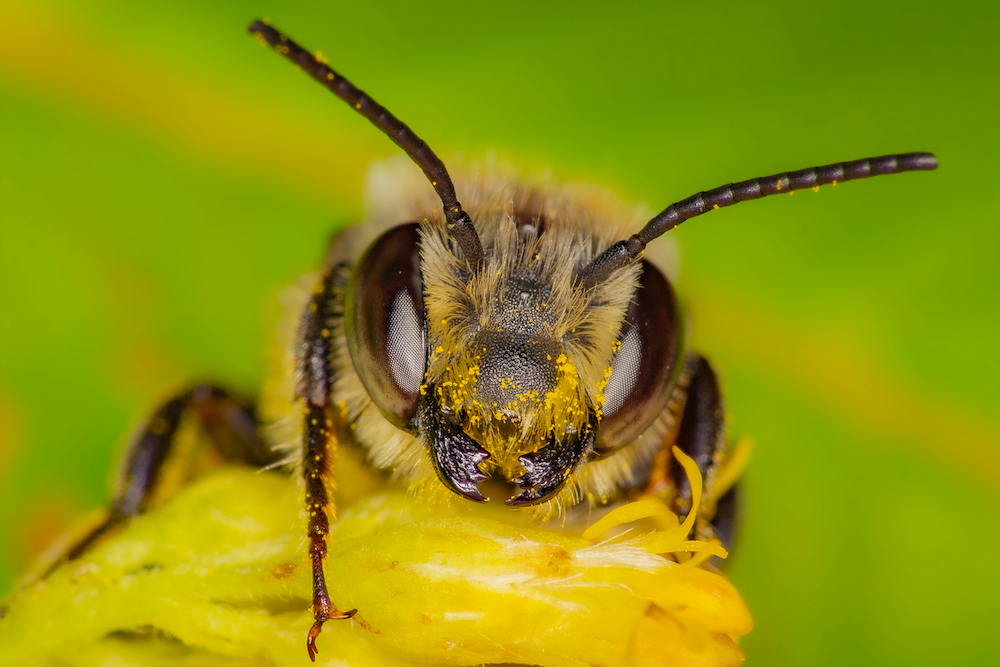Bee Anatomy: How Bees Use Their Antennae


When you think about a honey bee, you probably think about their fuzzy, yellow and black bodies. Or maybe their legs covered in pollen. You might not immediately think about their antennae. But, these structures are responsible for pretty much everything a honey bee does.
The antennae are the primary sensory structures on a bee. These two organs sit atop the bee’s head and perform many vital functions that contribute to the overall survival of a honey bee. Not only do they help a bee to smell, hear and taste, they can also do some pretty amazing things, such as determine wind speed, and even sense humidity and carbon dioxide levels.
Although they are tiny structures, bee antennae allow honey bees to collect the information they need to survive and contribute to the colony. They collect a great deal of information that bees use to find and collect food, control the temperature within the hive, communicate with the queen and care for their young. Let’s learn more about the structure and capabilities of honey bee antennae.
The Structure of Bee Antennae
As we mentioned earlier, bees have two antennae that jut out from the top of their heads. At the base of the antennae are muscles that control their movement, allowing each antenna to move in all directions. This allows the bee to collect information that gives them a clear picture of their environment. A fascinating fact about the structure of bee antennae is that they will vary slightly depending on the type of bee and their function within the hive.
Antennas are used for scent.
Worker bees forage for nectar and pollen. But did you ever consider how they find these substances? The sweet smell of nectar is what attracts bees to a flower. Forager bees want to find nectar with the highest sugar content because this is generally the most nutritious. Instead of haphazardly visiting flowers to test the sweetness of the nectar, honey bees use their antennae to smell the sweetness.
Their antennae contain receptors that can detect the smell of sugar, even when they are flying between their hive and a food source. Each antenna has the ability to detect the scent of sugar, helping the bee to choose where to go to get the best source.
An unfortunate reality is that a hive may contain some dead bees. While it is relatively rare to find many dead bees inside the hive, it can happen if there is some kind of mite or disease that has targeted the colony. These dead bees must be removed so they do not further spread diseases inside the hive and compromise the rest of the colony.
Specialized worker bees known as undertakers must remove these dead bees to a location away from the hive. They can find the dead bees using the odor receptors on their antennae. Dead bees have a specific odor that undertaker bees can detect, leading them to their fallen comrades so they can be taken away.
Another fascinating job of the antennae is their ability to detect pheromones that are released from the queen bee. For example, when a queen wants to mate with a drone, she will release a special hormone to attract the male bees. The drones’ antennae are adept at sensing this pheromone, helping the queen fulfill her role in the hive.
The queen has other pheromones that communicate to the worker bees. The pheromones will alert the bees to danger, the need for more foragers and overall direct the happenings within the hive.
Antennas are used for touch.
Bees use movement as one way to communicate with each other. This is frequently called the waggle dance and it shares information about the location of food and water sources, among other things. The bees’ antennae can touch another bee to help them understand the movements. Bees also use their antennae to work together to pass honey from bee to bee and to construct the cells of the hive using beeswax.
Just another fascinating aspect of the honeybee! The antennae help a bee communicate with other members of the hive and find valuable food and resources they need to support the colony. It is truly amazing how these two tiny structures can do so much to promote a thriving colony.
If you would like to learn more about the anatomy of honey bees, check out these articles from the D-Tek Live Bee Removal bee blog:
